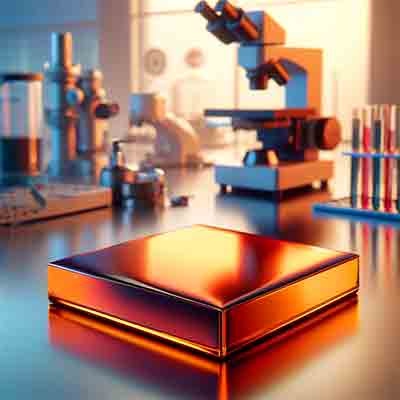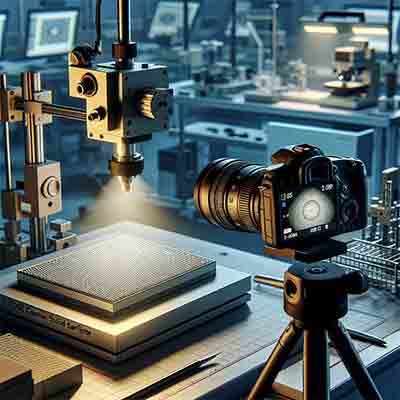Bulk CdSe Substrates to Calibrate Cameras
An experimental physicist requested a quote for the following:
Hi, I was wondering if you sell bulk CdSe substrates. It is just for calibrating a camera at around 710 nm. The substrate size can be anything in between 10 mm x 10 mm to 30 mm x 30 mm.
The sample is for calibration purpose. As far as you can provide something that will emit around 710 nm, should be good enough. The homogeneous or inhomogeneous linewidths or temperature dependent behaviour will not matter. Ideally, I would want a 27 mm x 27 mm substrate. If you need more info, please do get in touch. Thanks.
UniversityWafer, Inc. Responded:
The basic absorption edge of CdSe (at room temperature) is about 735 nm. As far as we understand, CdSe couldn't emit at 710 nm, as it absorbs light with this wavelength.
Here is our quote:
CdSe with high resistivity >= 1011 Ohm*cm, Ori (10-10), 25mm x 25mm x 0.5mm, 2 sides polished 60/40 (Scratch/Dig).
Reference # 274879 for specs and pricing.
Get Your Quote FAST! Or, Buy Online and Start Researching Today!
What is a CdSe Substrate?
A cadmium selenide (CdSe) substrate is a material used in various optical and electronic applications due to its unique properties. Here are some key points about CdSe substrates:
Properties of CdSe Substrates
- Semiconducting Nature: CdSe is a II-VI semiconductor with a direct bandgap, making it useful in
 optoelectronic devices.
optoelectronic devices.
- Bandgap Energy: It has a bandgap of approximately 1.74 eV at room temperature, which corresponds to the visible light spectrum, particularly in the red to orange region.
- Optical Properties: CdSe exhibits strong absorption and emission in the visible range, making it suitable for light-emitting diodes (LEDs), lasers, and photodetectors.
- Photoconductivity: It shows significant photoconductivity, meaning its electrical conductivity increases when exposed to light, useful in photodetectors and solar cells.
Applications of CdSe Substrates
- Optoelectronics: Used in the fabrication of LEDs, laser diodes, and photodetectors due to its efficient light emission and detection properties.
- Solar Cells: Employed in thin-film solar cells as an absorber layer to convert sunlight into electricity.
- Quantum Dots: CdSe nanoparticles (quantum dots) are used in displays, biological imaging, and as fluorescent tags due to their tunable optical properties.
- Transistors: Utilized in high-frequency and high-power electronic devices.
Fabrication and Usage
- Thin Film Deposition: CdSe can be deposited as a thin film on various substrates using techniques like chemical vapor deposition (CVD), molecular beam epitaxy (MBE), and sputtering.
- Substrate Material: While CdSe itself can be used as a substrate, it is often used as a thin film on other substrates like glass, silicon, or sapphire, depending on the application.
- Integration with Other Materials: CdSe is often combined with other materials to enhance its properties or to create heterostructures for advanced optoelectronic devices.
Summary
CdSe substrates are valuable in various advanced technologies due to their semiconducting properties, optical characteristics, and versatility in device fabrication. Their applications span optoelectronics, solar energy, quantum dots, and high-performance electronics.
How are Cadmium Selenide Wafers Used to Calibrate Cameras?
Cadmium selenide (CdSe) substrates can be used to calibrate cameras, particularly in terms of color accuracy and sensor performance, due to their well-defined optical properties. Here's how CdSe substrates can be utilized in camera calibration:
1. Spectral Response Calibration
- Emission Characteristics: CdSe has specific emission wavelengths in the visible spectrum, which can
 be used to calibrate the spectral response of camera sensors.
be used to calibrate the spectral response of camera sensors.
- Light Source: CdSe substrates can be excited using a light source to emit light at known wavelengths.
- Measurement: The camera under calibration captures the emitted light, and the response at different wavelengths is measured.
- Adjustment: The camera's settings or post-processing algorithms are adjusted to ensure accurate color reproduction based on the known emission spectrum of CdSe.
2. Color Accuracy Calibration
- Color References: CdSe substrates can be used as a reference for specific colors (particularly red and orange due to its bandgap energy).
- Image Capture: The camera captures images of the CdSe substrate under controlled lighting conditions.
- Comparison: The captured images are compared to the known color characteristics of CdSe.
- Calibration: The camera's color settings are adjusted to match the reference colors, ensuring that the camera accurately captures the true colors of scenes.
3. Brightness and Contrast Calibration
- Controlled Illumination: CdSe substrates can be illuminated uniformly to provide a consistent light source for calibrating brightness and contrast settings.
- Uniform Response: Since CdSe substrates can produce a uniform emission, they can be used to ensure that the camera's response to light is even across the entire sensor.
- Calibration Process: The camera captures the illuminated substrate, and any discrepancies in brightness and contrast are corrected through calibration.
4. Sensor Linearity and Dynamic Range
- Stepwise Illumination: By illuminating the CdSe substrate at different intensities, the linearity and dynamic range of the camera sensor can be assessed.
- Response Measurement: The camera's response to varying light intensities from the CdSe substrate is measured.
- Adjustment: Calibration involves adjusting the camera settings to ensure a linear response and maximize the dynamic range.
Calibration Procedure
- Preparation: Place the CdSe substrate in a controlled lighting environment with known and stable light sources.
- Capture Images: Use the camera to capture images of the CdSe substrate under various lighting conditions.
- Analysis: Analyze the captured images to determine the camera's response to the known emission characteristics of CdSe.
- Adjustment: Adjust the camera settings, such as white balance, exposure, and color profiles, based on the analysis to ensure accurate calibration.
- Verification: Capture additional images of the CdSe substrate and other calibration targets to verify the calibration accuracy.
Benefits
- High Precision: CdSe substrates offer precise and reproducible emission properties, making them ideal for calibration.
- Specific Wavelengths: The well-defined emission wavelengths of CdSe help in accurately calibrating the spectral response of cameras.
- Consistency: CdSe substrates provide a consistent reference, reducing variability in calibration results.
Summary
CdSe substrates are useful tools for calibrating cameras, particularly for ensuring accurate color reproduction, spectral response, brightness, contrast, linearity, and dynamic range. By using the specific optical properties of CdSe, cameras can be finely tuned to capture accurate and consistent images across various conditions.

 optoelectronic devices.
optoelectronic devices. be used to calibrate the spectral response of camera sensors.
be used to calibrate the spectral response of camera sensors.